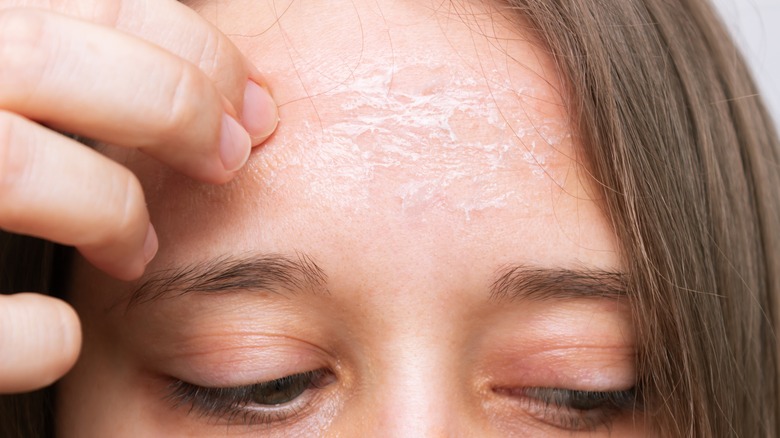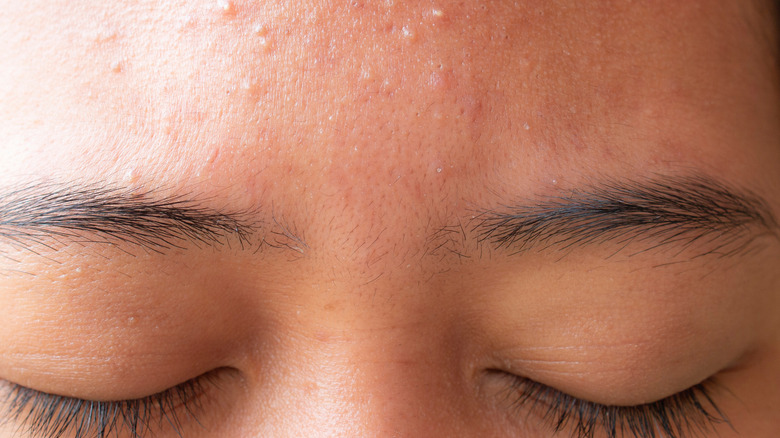Why The Skin On Your Forehead May Be Flaking
No one wants to deal with dry and flaky skin, especially on the face. Treating flaky skin can be frustrating as it can be difficult to pinpoint the exact cause. There are many reasons why the skin on your forehead may be flaking, including climate and hydration levels. In fact, both of these factors are related in that they are caused by a lack of moisture. When the weather turns cold in the winter, for instance, the air lacks moisture (via the Cleveland Clinic). The skin typically absorbs water from the surrounding environment to stay hydrated, so the lack of moisture in the air in dryer climates can lead to dryness and flaking.
A lack of moisture is not the only possible reason for flaky skin, however, as an excess of moisture can also cause flakiness, albeit for different reasons. With that being said, the most common causes of flaky skin on the forehead include certain skin conditions, acne, and allergic reactions. Here's how to find out the specific cause of your flaky skin and the best way to treat a flaky forehead.
Is seborrheic dermatitis causing your flaky skin?
Seborrheic dermatitis, or 'cradle cap', is a common condition that causes dry and flaky skin. Seborrheic dermatitis is non-contagious. According to the American Academy of Dermatology, the typical symptoms of seborrheic dermatitis include a rash and flaky, dry, itchy, or greasy skin.
The rash is commonly seen on oily areas of the skin, such as the face and scalp. This condition is known as 'cradle cap' as it can manifest as crusty or oily patches on the scalp, though it can also develop on other areas of your face, such as the eyebrows, beard, ears, nostrils, and forehead (via the Mayo Clinic).
You are more vulnerable to developing this condition if you have certain health issues, such as a neurological disease, a congenital disorder, or depression, or if you take certain medications, per the Cleveland Clinic.
To diagnose seborrheic dermatitis, it is best to reach out to a health professional or dermatologist as symptoms can overlap with other skin conditions, making at-home treatment difficult (via the American Academy of Dermatology). Treatment may involve a medicated shampoo, a topical ointment, corticosteroids, or a combination of treatment options depending on severity.
What else causes flaky skin?
If your flaky forehead is accompanied by acne breakouts or small bumps, then you may be experiencing something called 'pomade acne'. This form of acne typically occurs along the hairline and forehead as a result of certain hair products (via the American Academy of Dermatology). Many shampoos, conditioners, gels, and creams contain oil-based ingredients that can clog the pores along your scalp and hairline, per Curology.
To treat pomade acne, you can experiment to identify and avoid the guilty products, or you can try cleansing your face after applying your hair products to remove any residual product on the skin. You'll also want to clean anything that has touched your head, such as hats and pillowcases.
Other possible causes for flaking skin include atopic dermatitis and psoriasis, both of which are common skin conditions associated with dry, patchy, and flaky skin. Atopic dermatitis is a type of eczema that can feel itchy, hot, or painful (via Healthline). Contact dermatitis can arise as an allergic reaction to a product that you use.
Psoriasis, on the other hand, is an autoimmune condition that causes dry, scaly plaques to form on the skin and scalp, per Healthline. Specifically, hairline psoriasis, sebopsoriasis, and facial psoriasis can all cause dry and flaky skin across the forehead region.
If you suspect you have any of the aforementioned conditions, it is highly recommended that you reach out to a health professional for an accurate diagnosis, as it can be dangerous to treat the wrong condition and risk damaging your skin.


